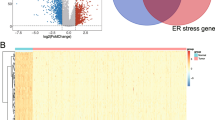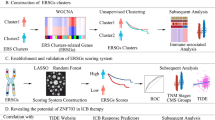Summary
Objective
Stomach adenocarcinoma (STAD) is caused by malignant transformation of gastric glandular cells and is characterized by a high incidence rate and a poor prognosis. This study was designed to establish a prognostic risk model for STAD according to endoplasmic reticulum (ER) stress feature genes as cancer cells are susceptible to ER stress.
Methods
The TCGA-STAD dataset was downloaded to screen differentially expressed genes (DEGs). By intersecting DEGs with ER stress genes retrieved from GeneCards, ER stress-related DEGs in STAD were obtained. Kmeans cluster analysis of STAD subtypes and Single sample gene set enrichment analysis (ssGSEA) analysis of immune infiltration were performed. Cox regression analysis was utilized to construct a risk prognostic model. Samples were split into high-risk and low-risk groups according to the median risk score. Survival analysis and Receiver Operating Characteristic (ROC) curves were conducted to assess the validity of the model. Gene set enrichment analysis (GSEA) was performed to investigate differential pathways in the two risk groups. Cox analysis was performed to verify the independence of the risk model, and a nomogram was generated.
Results
A total of 162 ER stress-related DEGs in STAD were identified by bioinformatics analysis. Kmeans cluster analysis showed that STAD was divided into 3 subgroups. The ssGSEA showed that the levels of immune infiltration in subgroups 2 and 3 were significantly higher than subgroup 1. With 12 prognostic genes (MATN3, ATP2A1, NOX4, AQP11, HP, CAV1, STARD3, FKBP10, EGF, F2, SERPINE1, CNGA3) selected from ER stress-related DEGs using Cox regression analysis, we then constructed a prognostic model. Kaplan-Meier (K‑M) survival curves and ROC curves showed good prediction performance of the model. Significant enrichment of genes in the high-risk group was found in extracellular matrix (ECM) receptor interaction. Cox regression analysis combined with clinical factors showed that the risk model could be used as an independent prognostic factor. The prediction correction curve showed that the good prediction ability of the nomogram.
Conclusion
The STAD could be divided into three subgroups, and the 12-gene model constructed by ER stress signatures had a good prognostic performance for STAD patients.









Similar content being viewed by others
References
Gu Z, Wang L, Yao X, Long Q, Lee K, Li J, et al. ClC-3/SGK1 regulatory axis enhances the olaparib-induced antitumor effect in human stomach adenocarcinoma. Cell Death Dis. 2020;11:898.
Venerito M, Vasapolli R, Rokkas T, Malfertheiner P. Gastric cancer: epidemiology, prevention, and therapy. Helicobacter. 2018;23(Suppl 1):e12518.
Thrift AP, El-Serag HB. Burden of gastric cancer. Clin Gastroenterol Hepatol. 2020;18:534–42.
Kawada J, Mizuno M, Fukada A, Nakano M, Murotani M, Nagano S, et al. Analysis of chemotherapy-induced nausea and vomiting during chemotherapy for gastric cancer. Gan To Kagaku Ryoho Cancer Chemother. 2022;49:462–4.
Wang BC, Zhang ZJ, Fu C, Wang C. Efficacy and safety of anti-PD-1/PD-L1 agents vs chemotherapy in patients with gastric or gastroesophageal junction cancer: a systematic review and meta-analysis. Medicine. 2019;98:e18054.
Ilson DH. Advances in the treatment of gastric cancer. Curr Opin Gastroenterol. 2019;35:551–4.
Brar G, Shah MA. The role of pembrolizumab in the treatment of PD-L1 expressing gastric and gastroesophageal junction adenocarcinoma. Therap Adv Gastroenterol. 2019;12:1756284819869767.
Sun S, Tang X, Guo Y, Hu J. Endoplasmic reticulum composition and form: proteins in and out. Curr Opin Cell Biol. 2021;71:1–6.
Qi Z, Chen L. Endoplasmic reticulum stress and autophagy. Adv Exp Med Biol. 2019;1206:167–77.
Chen X, Cubillos-Ruiz JR. Endoplasmic reticulum stress signals in the tumour and its microenvironment. Nat Rev Cancer. 2021;21:71–88.
Xu YY, You YW, Ren XH, Ding Y, Cao J, Zang WD, et al. Endoplasmic reticulum stress-mediated signaling pathway of gastric cancer apoptosis. Hepatogastroenterology. 2012;59:2377–84.
Xin H, Deng Y, Cao J. Proviral insertion in murine lymphomas 2 promotes stomach cancer progression by regulating apoptosis via reactive oxygen species-triggered endoplasmic reticulum stress. Biochem Biophys Res Commun. 2018;506:145–52.
Robinson MD, McCarthy DJ, Smyth GK. edgeR: a Bioconductor package for differential expression analysis of digital gene expression data. Bioinformatics. 2010;26:139–40.
Yu G, Wang LG, Han Y, He QY. clusterProfiler: an R package for comparing biological themes among gene clusters. OMICS. 2012;16:284–7.
Wilkerson MD, Hayes DN. ConsensusClusterPlus: a class discovery tool with confidence assessments and item tracking. Bioinformatics. 2010;26:1572–3.
Yoshihara K, Shahmoradgoli M, Martínez E, Vegesna R, Kim H, Torres-Garcia W, et al. Inferring tumour purity and stromal and immune cell admixture from expression data. Nat Commun. 2013;4:2612.
Sengupta D. Modeling survival data: extending the cox model. Sankhya Indian J Stat. 2003;65:843–4.
Friedman J, Hastie T, Tibshirani R. Regularization paths for generalized linear models via coordinate descent. J Stat Softw. 2010;33:1–22.
Blanche P, Dartigues JF, Jacqmin-Gadda H. Estimating and comparing time-dependent areas under receiver operating characteristic curves for censored event times with competing risks. Stat Med. 2013;32:5381–97.
Huang C, Liu Z, Xiao L, Xia Y, Huang J, Luo H, et al. Clinical significance of serum CA125, CA19‑9, CA72‑4, and fibrinogen-to-lymphocyte ratio in gastric cancer with peritoneal dissemination. Front Oncol. 2019;9:1159.
Tavakoli F, Khatami SS, Momeni F, Azadbakht J, Ghasemi F. Gastric cancer diagnosis: from imaging techniques to biochemical biomarkers. Curr Mol Med. 2021;21:355–75.
Wang Y, Wang JH, Zhang XL, Wang XL, Yang L. Endoplasmic reticulum chaperone glucose-regulated protein 78 in gastric cancer: an emerging biomarker. Oncol Lett. 2018;15:6087–93.
Jadeja SD, Mayatra JM, Vaishnav J, Shukla N, Begum R. A concise review on the role of endoplasmic reticulum stress in the development of autoimmunity in Vitiligo pathogenesis. Front Immunol. 2020;11:624566.
Wang J, He W, Tsai PJ, Chen PH, Ye M, Guo J, et al. Mutual interaction between endoplasmic reticulum and mitochondria in nonalcoholic fatty liver disease. Lipids Health Dis. 2020;19:72.
Wang Y, Wang K, Jin Y, Sheng X. Endoplasmic reticulum proteostasis control and gastric cancer. Cancer Lett. 2019;449:263–71.
Wu J, Chen YJ, Dobbs N, Sakai T, Liou J, Miner JJ, et al. STING-mediated disruption of calcium homeostasis chronically activates ER stress and primes T cell death. J Exp Med. 2019;216:867–83.
Shyamasundar LG, Loganathan L, Kumar A, Selina A, Madhuri V. MATN3 mutation causing Spondyloepimetaphyseal dysplasia. Indian J Pediatr. 2020;87:227–8.
Ding J, Liu Y, Lai Y. Identifying MMP14 and COL12A1 as a potential combination of prognostic biomarkers in pancreatic ductal adenocarcinoma using integrated bioinformatics analysis. PeerJ. 2020;8:e10419.
Li D, Xu J, Dong X, Chen W, Pan L, Jiang H, et al. Diagnostic and prognostic value of MATN3 expression in gastric carcinoma: TCGA database mining. J Gastrointest Oncol. 2021;12:1374–83.
Vermot A, Petit-Hartlein I, Smith SME, Fieschi F. NADPH Oxidases (NOX): an overview from discovery, molecular mechanisms to physiology and pathology. Antioxidants. 2021;10:890. https://doi.org/10.3390/antiox10060890.
Xiao R, Wang S, Guo J, Liu S, Ding A, Wang G, et al. Ferroptosis-related gene NOX4, CHAC1 and HIF1A are valid biomarkers for stomach adenocarcinoma. J Cell Mol Med. 2022;26:1183–93.
Zhang X, Zheng P, Li Z, Gao S, Liu G. The somatic mutation landscape and RNA prognostic markers in stomach adenocarcinoma. Onco Targets Ther. 2020;13:7735–46.
Thapa S, Chetry M, Huang K, Peng Y, Wang J, Wang J, et al. Significance of aquaporins’ expression in the prognosis of gastric cancer. Biosci Rep. 2018;38:BSR20171687.
Wang S, Wang N, Zheng Y, Zhang J, Zhang F, Wang Z. Caveolin-1: an oxidative stress-related target for cancer prevention. Oxid Med Cell Longev. 2017;2017:7454031.
Luo Z, Rong Z, Zhang J, Zhu Z, Yu Z, Li T, et al. Circular RNA circCCDC9 acts as a miR-6792-3p sponge to suppress the progression of gastric cancer through regulating CAV1 expression. Mol Cancer. 2020;19:86.
Wilhelm LP, Wendling C, Vedie B, Kobayashi T, Chenard MP, Tomasetto C, et al. STARD3 mediates endoplasmic reticulum-to-endosome cholesterol transport at membrane contact sites. EMBO J. 2017;36:1412–33.
Asif K, Memeo L, Palazzolo S, Frion-Herrera Y, Parisi S, Caligiuri I, et al. STARD3: a prospective target for cancer therapy. Cancers. 2021;13:4693. https://doi.org/10.3390/cancers13184693.
Kwon MJ, Kim RN, Song K, Jeon S, Jeong HM, Kim JS, et al. Genes co-amplified with ERBB2 or MET as novel potential cancer-promoting genes in gastric cancer. Oncotarget. 2017;8:92209–26.
Ishikawa Y, Holden P, Bachinger HP. Heat shock protein 47 and 65-kDa FK506-binding protein weakly but synergistically interact during collagen folding in the endoplasmic reticulum. J Biol Chem. 2017;292:17216–24.
Liang L, Zhao K, Zhu JH, Chen G, Qin XG, Chen JQ. Comprehensive evaluation of FKBP10 expression and its prognostic potential in gastric cancer. Oncol Rep. 2019;42:615–28.
Gong LB, Zhang C, Yu RX, Li C, Fan YB, Liu YP, et al. FKBP10 acts as a new biomarker for prognosis and lymph node metastasis of gastric cancer by bioinformatics analysis and in vitro experiments. Onco Targets Ther. 2020;13:7399–409.
Wang RG, Zhang D, Zhao CH, Wang QL, Qu H, He QS. FKBP10 functioned as a cancer-promoting factor mediates cell proliferation, invasion, and migration via regulating PI3K signaling pathway in stomach adenocarcinoma. Kaohsiung J Med Sci. 2020;36:311–7.
Dai M, Yip YY, Todaro G, Hellstrom I, Hellstrom KE. Antibodies to EGF receptor family members can upregulate tumor immunity. J Immunother. 2021;44:355–61.
Han J, Xie Y, Lan F, Yu Y, Liu W, Chen J, et al. Additive effects of EGF and IL-1beta regulate tumor cell migration and invasion in gastric adenocarcinoma via activation of ERK1/2. Int J Oncol. 2014;45:291–301.
Chen TY, Zhou M, Lin MQ, Liang ST, Yan Y, Wang SM, et al. Research progress on the SERPINE1 protein and chronic inflammatory diseases of the upper respiratory tract: a literature review. Int Arch Allergy Immunol. 2021;182:1097–102.
Li L, Zhu Z, Zhao Y, Zhang Q, Wu X, Miao B, et al. FN1, SPARC, and SERPINE1 are highly expressed and significantly related to a poor prognosis of gastric adenocarcinoma revealed by microarray and bioinformatics. Sci Rep. 2019;9:7827.
Zhang G, Shang H, Liu B, Wu G, Wu D, Wang L, et al. Increased ATP2A1 predicts poor prognosis in patients with colorectal carcinoma. Front Genet. 2022;13:661348.
Christodoulou P, Yiallouris A, Michail A, Christodoulou MI, Politis PK, Patrikios I. Altered SERCA expression in breast cancer. Medicina. 2021;57:1074.
Kohl S, Baumann B, Dassie F, Mayer AK, Solaki M, Reuter P, et al. Paternal uniparental isodisomy of chromosome 2 in a patient with CNGA3-associated autosomal recessive achromatopsia. Int J Mol Sci. 2021;22:7842.
Yousaf S, Tariq N, Sajid Z, Sheikh SA, Kausar T, Waryah YM, et al. Delineating the molecular and phenotypic spectrum of the CNGA3-related cone photoreceptor disorder in Pakistani families. Genes. 2022;13:617.
Zeltz C, Primac I, Erusappan P, Alam J, Noel A, Gullberg D. Cancer-associated fibroblasts in desmoplastic tumors: emerging role of integrins. Semin Cancer Biol. 2020;62:166–81.
Kwon A, Chae IH, You E, Kim SH, Ahn SY, Lee OJ, et al. Extra domain A‑containing fibronectin expression in Spin90-deficient fibroblasts mediates cancer-stroma interaction and promotes breast cancer progression. J Cell Physiol. 2020;235:4494–507.
Yang X, Chen L, Mao Y, Hu Z, He M. Progressive and prognostic performance of an extracellular matrix-receptor interaction signature in gastric cancer. Dis Markers. 2020;2020:8816070.
Author information
Authors and Affiliations
Contributions
XL conceived of the study and participated in its design and interpretation and draft of the manuscript. YL performed the statistical analysis and revised the manuscript critically. All authors reviewed and gave final approval of the version to be published.
Corresponding author
Ethics declarations
Conflict of interest
X. Li and Y. Lei declare that they have no competing interests.
Additional information
Publisher’s Note
Springer Nature remains neutral with regard to jurisdictional claims in published maps and institutional affiliations.
Data Availability Statements
The data that support the findings of this study are available on request from the corresponding author.
Rights and permissions
About this article
Cite this article
Li, X., Lei, Y. Construction of a prognostic risk model for Stomach adenocarcinoma based on endoplasmic reticulum stress genes. Wien Klin Wochenschr (2023). https://doi.org/10.1007/s00508-023-02306-0
Received:
Accepted:
Published:
DOI: https://doi.org/10.1007/s00508-023-02306-0




